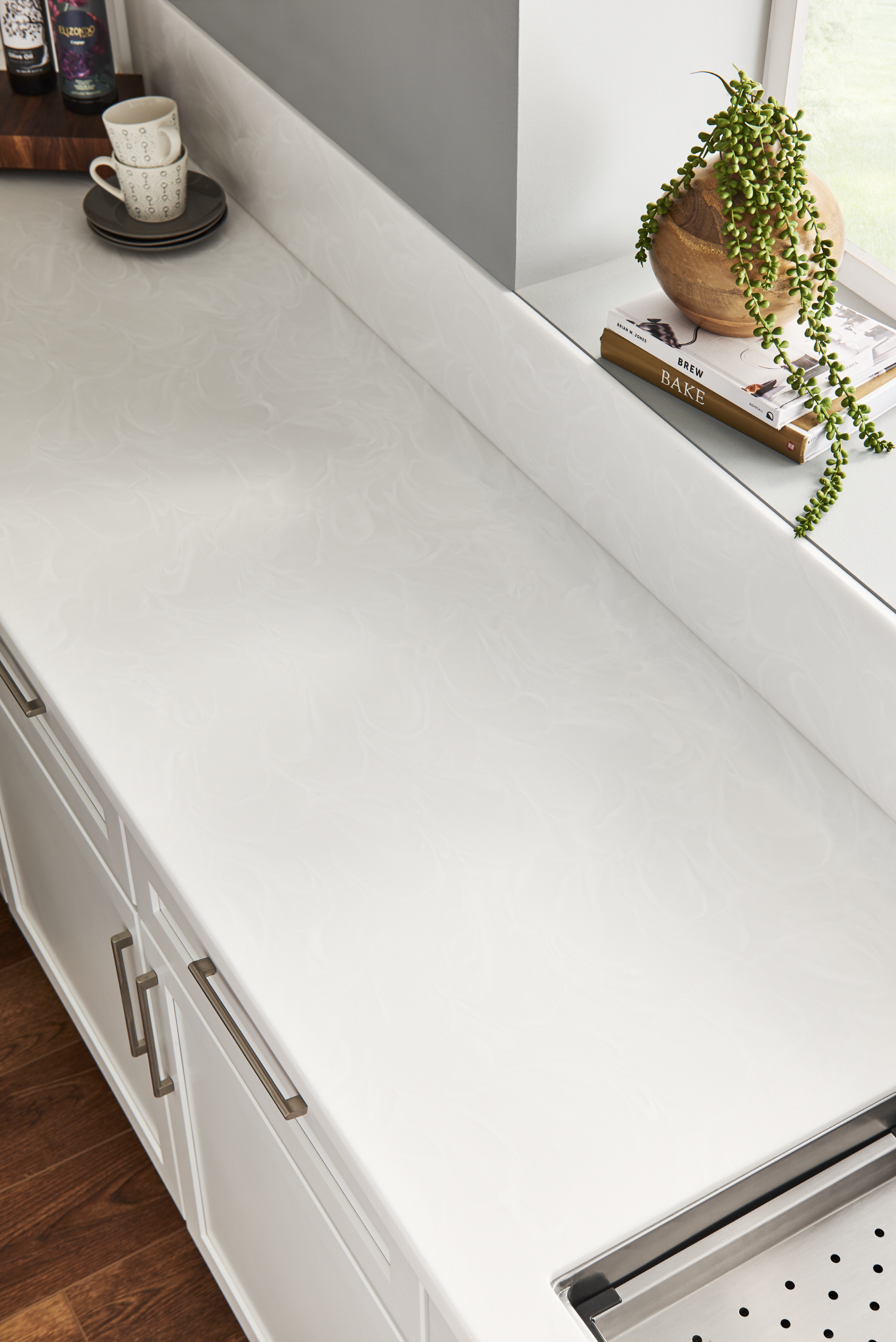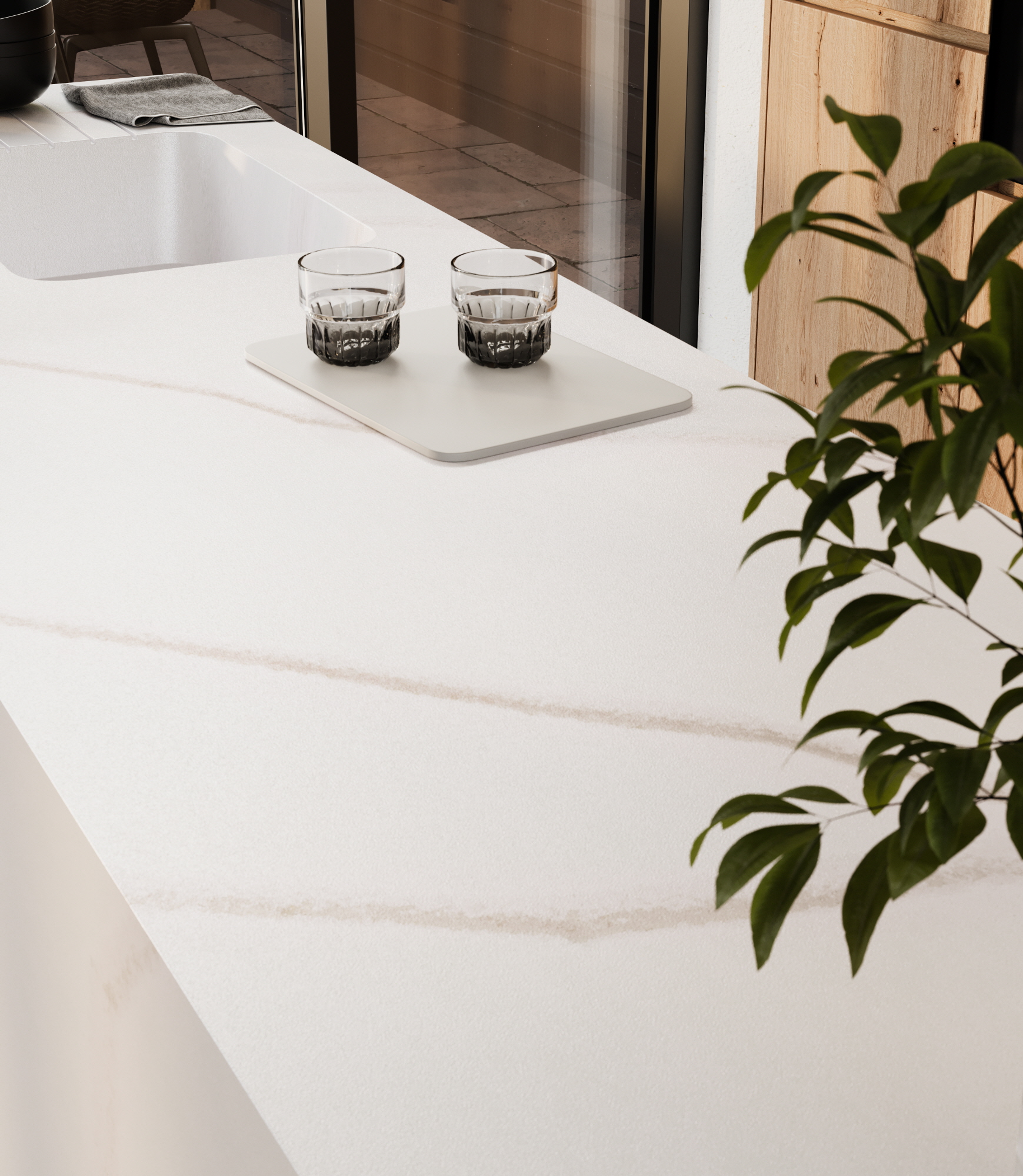A high-quality, durable countertop is central to the utility and aesthetics of any kitchen. It’s essential to choose the perfect countertop that not only meets your aesthetic requirements but also stands up to the demands of daily use. The right material selection is crucial in this regard. Durability, however, isn’t just a single attribute but a combination of qualities.
Consider the following factors when assessing durability:
- Heat resistance, which includes the countertop’s ability to withstand burns, melting, and scorches without damage.
- Resistance to chipping, breakage, and cracking, ensuring a long-lasting surface.
- Porosity, or the countertop’s ability to resist absorbing water, oils, and bacteria, which influences hygiene and maintenance.
- Maintenance requirements, particularly whether the material necessitates regular sealing to maintain its resilience and appearance.
In this article, we will explore seven of the most popular kitchen countertop materials. We aim to provide a comprehensive overview of their unique features, helping you make an informed decision about which durable countertop is best suited for your kitchen renovation.
Quartz

Quartz countertops, engineered through a manufacturing process that fuses natural quartz with resins, polymers, and pigments, offer robust durability. This material stands up effortlessly to scratches, stains, and heat, embodying an ideal blend of functionality and elegance for any kitchen. Additionally, its non-porous nature ensures that it won’t harbor bacteria or suffer damage from prolonged water exposure.
Despite its impressive attributes, quartz comes with a notable caveat: cost. It ranks among the pricier options on the market, with prices spanning from $60 to $120 per square foot. Moreover, while quartz is heat resistant, it isn’t entirely impervious to heat. Exposing it to a hot pan may result in a discoloration known as “resin burn,” which manifests as a brown or yellow tint, serving as a reminder that quartz, while durable, has its limitations.
Granite
Granite, a natural stone celebrated for its inherent beauty, is often a coveted feature in homes. Each slab of granite tells its own story, with a distinct mix of colors, veins, and patterns that cannot be replicated. Beyond its aesthetic allure, granite is robustly resistant to scratches, stains, and heat – you can confidently place a hot item directly on the counter without worrying about damage.
However, much like quartz, granite is associated with a higher cost, positioned at the upper end of the countertop materials market with prices ranging from $50 to $120 per square foot. Maintenance is another consideration; to maintain its resistance to water, oil, and stains, granite requires annual sealing. Despite these considerations, its timeless appeal continues to make granite a desirable choice for those who prioritize beauty and durability in their kitchen design.
Laminate
Laminate countertops have surged in popularity thanks to their budget-friendly nature, with costs typically varying from $20 to $60 per square foot. A composite of a laminate layer atop a fiberglass base, laminate countertops are a synthetic solution designed to replicate a wide range of aesthetics, from wood to stone, offering considerable visual flexibility. In addition to their cost-effective appeal, they are resistant to stains and do not require the sealing maintenance that natural materials demand.
However, there are drawbacks to consider. Laminate is not heat-resistant, and high temperatures can leave unattractive burn marks on the surface. Furthermore, laminate countertops may influence the resale value of your home negatively, as they are often less preferred by prospective homebuyers compared to their natural or engineered stone counterparts. Despite these potential cons, the affordability and visual adaptability of laminate make it an appealing choice for many homeowners.
Marble
Marble stands out as a favored choice among homebuyers and designers, celebrated for its luxurious appeal and striking veining that can transform it into a centerpiece in any space. This natural stone is not only visually captivating but also heat-resistant, allowing you to cook freely without the worry of burns or scorch marks damaging your countertop.
Despite its beauty and functionality, marble does have its downsides. It is susceptible to scratches, chips, and breakage, requiring careful use and maintenance. Additionally, to prevent liquid absorption and stains, regular sealing is necessary. Cost-wise, marble is at the higher end, ranging from $50 to $100 per square on average. While marble may require a bit more care and investment, its timeless elegance makes it a popular choice for those looking to add a touch of sophistication to their homes.
Soapstone
Soapstone countertops offer a distinct choice in the market, recognized for their tactile softness, a result of their unique chemical makeup. Remarkably, despite its soft feel, soapstone boasts impressive features: it is heatproof, less prone to cracking or breakage, and non-porous, ensuring that countertops remain free from bacterial build-up. Its substantial resistance to chemicals has even made soapstone a preferred material in laboratory settings.
The exclusivity of soapstone is reflected in its cost, with prices ranging from $75 to $120 per square foot, positioning it at the higher end of countertop materials. It’s important to note that soapstone, while durable, is softer than granite or marble and more susceptible to scratching. Nonetheless, for those who value singularity and practicality, soapstone remains an esteemed and viable option for countertops.
Tile
Tile countertops have long been a mainstay in interior design, cherished for their style and durability. They can withstand direct heat from stovetops, pans, or hot appliances without incurring any damage. Their resilience is matched by their suitability for wet environments; glazed tiles are completely waterproof, making them an ideal choice for kitchens, bathrooms, and outdoor spaces. Additionally, tile is highly cost-effective as countertop materials go, with a typical price range of $20-$40 per square foot.
However, there are some downsides to keep in mind. While the surface of the tiles can be wiped clean with ease, the grout lines present a challenge. They are prone to collecting dirt and debris and may discolor over time without regular and thorough cleaning. Also, tiles can chip or crack under certain conditions, but the upside is that you can replace individual tiles fairly easily if needed. Despite these considerations, tile remains a versatile and economical option for those seeking a stylish countertop solution.
Solid surface

Solid surface counters are crafted from a blend of resins, acrylic, natural minerals, and pigments, offering a more budget-friendly alternative to natural stone with prices typically ranging from $50 to $80 per square foot. They stand out for their ease of maintenance—requiring no sealing—and their high resistance to cracking. Additionally, solid surfaces are available in a vast array of colors and designs, allowing them to cater to a wide range of kitchen styles.
However, there is a notable drawback to consider. Due to their composition, which includes resins and other plastic elements, solid surface counters are susceptible to damage from high heat; they can melt, scorch, or warp if exposed to elevated temperatures. This vulnerability is something to bear in mind for those considering this material for their countertops.